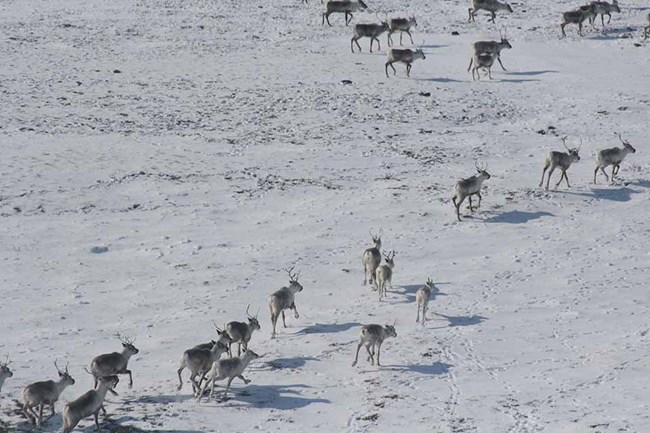Last updated: November 1, 2018
Article
Lichens are Critical Winter Forage for Caribou

NPS/Kyle Joly
Early fall and late winter diets of migratory caribou in northwest Alaska
Abstract
Lichens are the primary winter forage for large herds of migratory caribou (Rangifer tarandus). Caribou select for lichens more than they are available across the landscape and they generally avoid, during winter, habitat that has been burned by wildfires for decades while lichen abundance recovers. However, the relative importance of lichens in the diet is subject to debate. From 2010-2013, we conducted one of the largest microhistological studies of the early fall (58 samples from 1 site) and late winter (338 samples from 58 sites) diets of barren-ground caribou. Lichens constituted ~ 71% of the late winter diets of caribou in northwest Alaska, whereas moss (11%) and shrubs (9%) were the next most common forage items. Early fall diets were very similar to late winter, perhaps because deciduous vegetation is senescent during both periods. Diets of males, non-pregnant females and pregnant females were not significantly different. Pregnancy was not associated with the abundance of any forage type during winter but was associated with higher physiological stress. This result was expected as fall body condition dictates conception, caribou are ‘capital’ breeders, and gestation can be energetically demanding. Caribou that migrated south (i.e., wintered south of 67.1°N) had lower levels of nutritional stress, higher levels of lichen in the diet, and lower levels of moss and shrubs compared to caribou that did not migrate south. Future investigations into the potential connection between lichen abundance in the winter diet and survivorship, as well as linking the late summer diets of individuals to their reproductive success, should be undertaken.
Joly, K. and M. D. Cameron. 2018. Early fall and late winter diets of migratory caribou in northwest Alaska. Rangifer 38(1):27-38.
Non-invasive assessment of the interrelationships of diet, pregnancy rate, group composition, and physiological and nutritional stress of barren-ground caribou in late winter
Abstract
The winter diet of barren-ground caribou may affect adult survival, timing of parturition, neonatal survival, and postpartum mass. We used microhistological analyses and hormone levels in feces to determine sex-specific late-winter diets, pregnancy rates, group composition, and endocrine-based measures of physiological and nutritional stress. Lichens, which are highly digestible but contain little protein, dominated the diet (> 68%) but were less prevalent in the diets of pregnant females as compared to non-pregnant females and males. The amount of lichens in the diets of pregnant females decreased at higher latitudes and as winter progressed. Pregnancy rates (82.1%, 95% CI = 76.0 – 88.1%) of adult cows were within the expected range for a declining herd, while pregnancy status was not associated with lichen abundance in the diet. Most groups (80%) were of mixed sex. Male: female ratios (62:100) were not skewed enough to affect the decline. Levels of hormones indicating nutritional stress were detected in areas of low habitat quality and at higher latitudes. Levels of hormones indicated that physiological stress was greatest for pregnant cows, which faced the increasing demands of gestation in late winter. These fecal-based measures of diet and stress provided contextual information for the potential mechanisms of the ongoing decline. Non-invasive techniques, such as monitoring diets, pregnancy rates, sex ratios and stress levels from fecal samples, will become increasingly important as monitoring tools as the industrial footprint continues to expand in the Arctic.
Joly, K., S. K. Wasser, and R. Booth. 2015. Non-invasive assessment of the interrelationships of diet, pregnancy rate, group composition, and physiological and nutritional stress of barren-ground caribou in late winter. PLoS ONE 10(6): e0127586.
